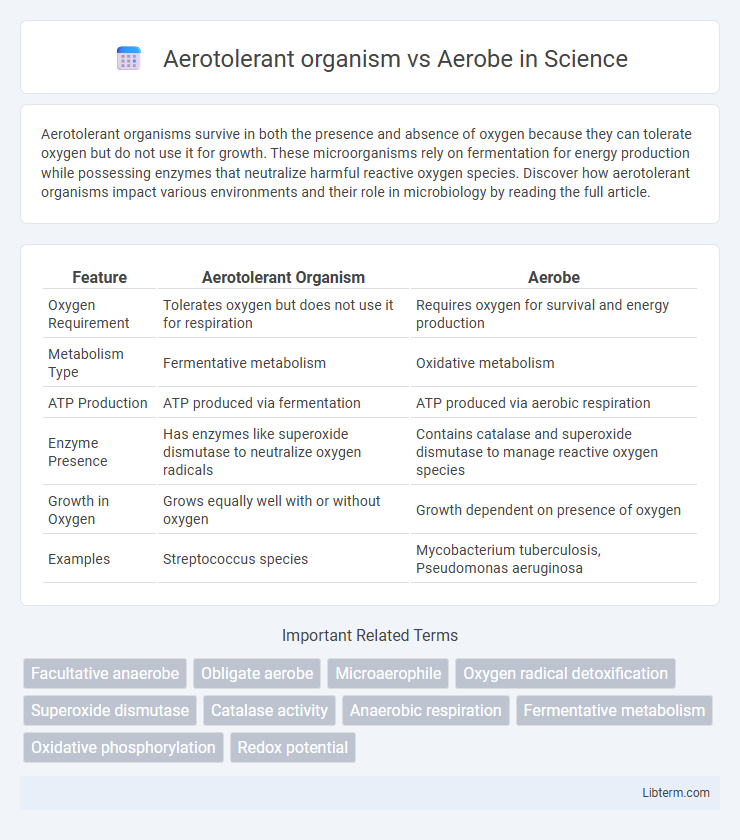Aerotolerant organisms survive in both the presence and absence of oxygen because they can tolerate oxygen but do not use it for growth. These microorganisms rely on fermentation for energy production while possessing enzymes that neutralize harmful reactive oxygen species. Discover how aerotolerant organisms impact various environments and their role in microbiology by reading the full article.
Table of Comparison
| Feature | Aerotolerant Organism | Aerobe |
|---|---|---|
| Oxygen Requirement | Tolerates oxygen but does not use it for respiration | Requires oxygen for survival and energy production |
| Metabolism Type | Fermentative metabolism | Oxidative metabolism |
| ATP Production | ATP produced via fermentation | ATP produced via aerobic respiration |
| Enzyme Presence | Has enzymes like superoxide dismutase to neutralize oxygen radicals | Contains catalase and superoxide dismutase to manage reactive oxygen species |
| Growth in Oxygen | Grows equally well with or without oxygen | Growth dependent on presence of oxygen |
| Examples | Streptococcus species | Mycobacterium tuberculosis, Pseudomonas aeruginosa |
Introduction to Aerotolerant Organisms and Aerobes
Aerotolerant organisms thrive in the presence of oxygen but do not utilize it for energy production, relying instead on anaerobic metabolic pathways. Aerobes require oxygen for their cellular respiration, using it as the final electron acceptor to efficiently generate ATP. Understanding the metabolic distinctions between aerotolerant organisms and aerobes is crucial for studying microbial ecology and physiology.
Defining Aerotolerant Organisms
Aerotolerant organisms are microorganisms that do not require oxygen for growth but can survive and metabolize in its presence, distinguishing them from aerobes that depend on oxygen for aerobic respiration. These organisms utilize fermentation to generate energy, allowing them to tolerate atmospheric oxygen without using it as the final electron acceptor. Aerotolerant bacteria include species like Lactobacillus, which thrive in oxygenated environments yet primarily rely on anaerobic metabolic pathways.
Defining Aerobes
Aerobes are organisms that require oxygen for cellular respiration and energy production, relying on oxygen as the final electron acceptor in their metabolic processes. Unlike aerotolerant organisms, which do not use oxygen but can survive its presence, aerobes depend on an oxygen-rich environment for growth and survival. This oxygen dependency differentiates aerobes fundamentally in their energy generation compared to facultative anaerobes and anaerobes.
Oxygen Requirements: Key Differences
Aerotolerant organisms can survive and grow in the presence of oxygen but do not require it for metabolism, relying on anaerobic pathways instead. Aerobes require oxygen for their energy production through aerobic respiration, using oxygen as the final electron acceptor in the electron transport chain. The key distinction lies in oxygen utilization: aerotolerant organisms tolerate oxygen without metabolizing it, whereas aerobes depend on oxygen for cellular respiration and energy generation.
Energy Production Mechanisms
Aerotolerant organisms produce energy primarily through fermentation, allowing ATP synthesis without utilizing oxygen, while aerobe organisms rely on aerobic respiration, where oxygen acts as the terminal electron acceptor in the electron transport chain for efficient ATP production. In aerotolerant microbes, enzymes like lactate dehydrogenase facilitate anaerobic metabolic pathways despite the presence of oxygen. Aerobic organisms utilize oxidative phosphorylation within mitochondria or cell membranes, maximizing energy yield by transferring electrons through complexes to oxygen, forming water.
Examples of Aerotolerant Organisms
Aerotolerant organisms, such as Streptococcus and Lactobacillus species, survive in the presence of oxygen but do not utilize it for growth, unlike obligate aerobes like Pseudomonas aeruginosa that require oxygen for metabolism. These aerotolerant bacteria rely on fermentation rather than aerobic respiration, allowing them to thrive in oxygen-rich environments without benefiting from oxygen's energy potential. Understanding the metabolic differences between aerotolerant organisms and aerobes is crucial in fields like microbiology and infectious disease management.
Examples of Aerobes
Examples of aerobes include Mycobacterium tuberculosis, Pseudomonas aeruginosa, and Bacillus subtilis, all of which require oxygen for growth and energy production through aerobic respiration. These organisms utilize oxygen as the final electron acceptor in the electron transport chain, ensuring efficient ATP synthesis. In contrast, aerotolerant organisms like Streptococcus pyogenes do not use oxygen but can survive in its presence without relying on it for metabolic processes.
Ecological Roles and Habitats
Aerotolerant organisms thrive in environments with fluctuating oxygen levels, such as soil and the human gut, where they ferment substrates without using oxygen for respiration. Aerobes dominate oxygen-rich habitats like surface waters and terrestrial ecosystems, efficiently producing energy through oxidative phosphorylation. Both play crucial ecological roles by maintaining nutrient cycles; aerotolerant organisms contribute to fermentation processes, while aerobes drive aerobic decomposition and energy flow.
Industrial and Medical Significance
Aerotolerant organisms, which survive in oxygen environments without using it for metabolism, are valuable in industrial fermentation processes where oxygen sensitivity complicates production, such as in yogurt and cheese manufacturing involving Lactobacillus species. Aerobes, requiring oxygen for energy generation, play critical roles in bioenergy production and biodegradation applications, exemplified by Pseudomonas bacteria in wastewater treatment. Medically, aerobes like Mycobacterium tuberculosis are targets for oxygen-dependent drug therapies, while aerotolerant pathogens such as Streptococcus pyogenes pose challenges due to their resistance to oxidative stress in human tissues.
Summary: Comparing Aerotolerant Organisms and Aerobes
Aerotolerant organisms survive in the presence of oxygen but do not use it for energy production, relying instead on fermentation, whereas aerobes require oxygen for cellular respiration to generate ATP efficiently. Both types possess mechanisms to protect against oxidative stress, but aerobes have specialized enzymes like catalase and superoxide dismutase that actively utilize oxygen in metabolism. The key distinction lies in oxygen utilization: aerobes depend on it for growth, while aerotolerant organisms tolerate oxygen without exploiting it for energy.
Aerotolerant organism Infographic

 libterm.com
libterm.com